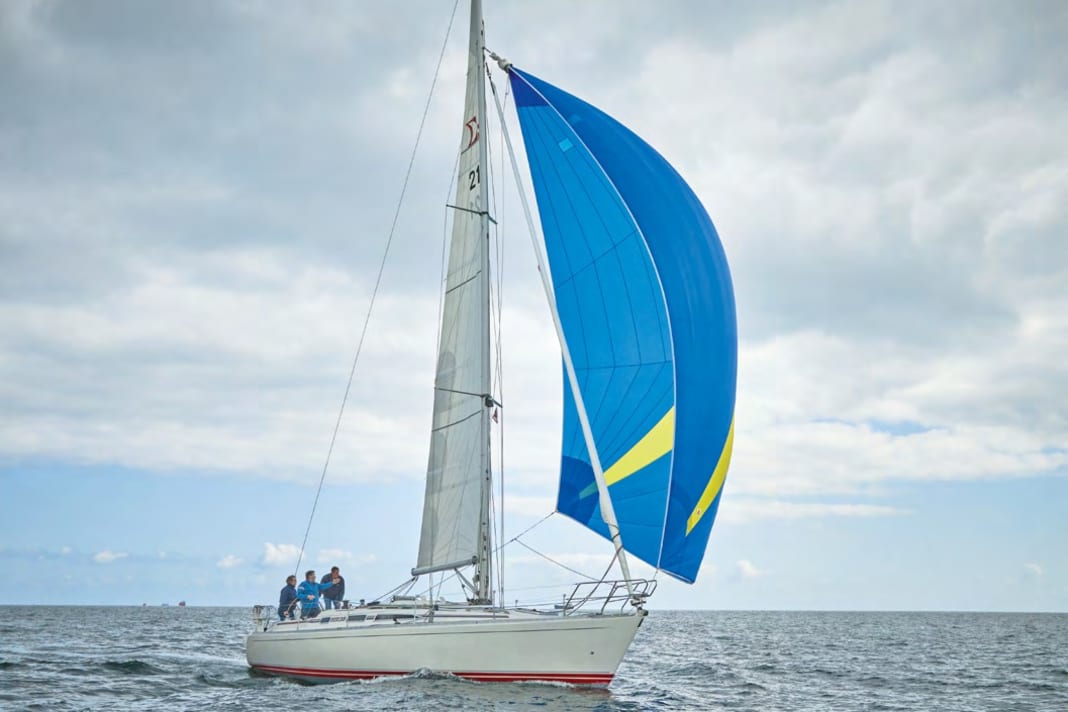Downwind sailing: Sailing correctly with gennaker & co - sailing pro Tim Kröger shows how it's done
YACHT-Redaktion
· 24.07.2023






Series: Sailing practice with Tim Kröger
- Rig trim Correctly adjust the mast profile with shrouds and stays
- Sail trim Giving the sails the ideal profile on all courses
- Optimal crossing Sailing perfectly to windward with the right tactics
- Downwind sailingCruising faster downwind with gennaker & co
Asymmetric sails have become increasingly popular in recent years, and there are many good reasons for this. Not only has their performance downwind been enormously improved by better gennaker designs. Handling when setting, recovering and in manoeuvres is also many times easier than the struggle with the symmetrical spinnaker, which includes the beast called the spinnaker pole.
Handling the gennaker is the same on every boat. Whether it's a 100-foot maxi or a 20-foot keelboat, one person steers, one handles the mainsail and two handle the gennaker. One of them unfurls the sheet in the jibe and one takes it tight again on the other side.
It is logical that one person alone can carry out these tasks on a 20-foot boat, and it is just as logical that many additional crew members are involved on a 100-foot maxi. My point here is the basic principles of sailing with a gennaker.
Downwind sailing: how to set the gennaker correctly
As with any manoeuvre, good preparation is everything. Once a sail has been set incorrectly, it not only looks a little embarrassing from the outside. It could also take an annoying amount of time to dismantle it.
Attaching the gennaker is conceptually simple. The tack goes to the bow to the most important trim element of the sail, the tack line. The attachment point of the tack line varies greatly from boat to boat. The options range from a solid carbon bowsprit with a water stay to a short stub bowsprit made of stainless steel to a deflection block that is attached to the powerful anchor fitting on the bow.
On our boat, a Sigma 38, the tackle line deflection block is attached to the anchor fitting with a soft shackle. This is sufficient for small gennakers, especially if you are sailing with the family and want to use the sail in a wind range of eight to 15 knots. The tack line is led to the back of a clamp and secured there.
Good preparation for the downwind is crucial
If you want to sail your gennaker in stronger winds, you should think about a solid fitting, because: The forces generated on the tack line are considerable. However, one thing is always the same with the attachment point. It should be located directly on the bow at the maximum distance in front of the forestay. Modern cruising yachts usually have short bow pulpits, which are also split, as these yachts are already designed for gennakers.
The split pulpit has another advantage. Before setting, the tack line can be pulled forwards under the headsail and between the pulpit and forestay without the wind and waves grabbing the neck and carrying the whole sail out of the bag and into the sea.
It is ideal to prepare for setting in a relaxed manner on a room sheet course and to hoist the sail when everything is clear. Tighten the tack line slightly before setting and secure it well in the cleat. Rushing out can end in chaos.
Gennaker sailing: the right sheet length
There are gennakers that are attached firmly to the bow fitting, without a line, with a soft shackle or similar. If the sheet can then be pulled up to the halyard outlet, that's fine too. The only problem is that you are depriving yourself of an important trim element by fixing it.
A sensible simplification is to connect the sheets to the sail via a common stander, because then only one soft shackle goes to the clew. This saves time and reduces the risk of losing a sheet.
A good length for the sheets themselves is slightly more than twice the length of the boat. Depending on the size of the boat, the stander is between 20 centimetres and half a metre long. If it is too long, it will make jibing more difficult. More on this later. The halyard goes to the head of the sail and is attached to the outside of the headsail.
Downwind sailing: stowing the gennaker correctly
There are many different aids for setting the gennaker: On cruising yachts, the snuffer has proven itself and works really well. If you work with such a "snuffer", you can also furl the headsail during the manoeuvre, set the gennaker with the tube, then briefly check whether the recovery line is running clear and pull up the recovery tube before the wind, tighten the sheet and set course.
On regatta yachts, people have started to sew a zip into the luff of the gennaker over a specified length and another strip of cloth with the counterpart of the zip parallel to the luff. The distance is determined by the size of the gennaker and the thickness of the cloth.
Packing is simple: you walk along the leech so that the sail is not twisted in on itself and roll the cloth in from the head towards the luff. You automatically have the counterpart of the zip in your hand and close it from the head downwards. The whole sailcloth is folded in on itself at the end and the zip closes the sausage.
Clever: Tim Kröger's experiences with the gennaker in the Southern Ocean
The concept is almost ingenious, as you now have a compact sausage-shaped sail that can be easily stowed away in its bag. However, it is very important when packing that the end of the zip is opened. The sailmaker has sewn on a small Velcro flap to prevent the entire zip from coming undone. Once the sail is set and the sheet is pulled, the zip opens along the entire length of the luff and the gennaker is trimmed.
During my first race around the world on board the "Intrum Justitia", we didn't yet have any zip fasteners installed on the sail. However, as a recovery tube doesn't really make sense on a racing yacht because handling takes longer and time is an important factor in races, we were already on a similar path.
We had a long tube with a zip into which the gennaker was packed and then closed with a zip. At the lower end there was a flap, like a nappy, which was wrapped around the foot of the sail and closed and secured the open zip with lots of Velcro.
Which gennaker is the right one for my boat?
This meant that we were able to fully hoist the gennaker in the Southern Ocean without setting the headsail. The exciting moment was opening the flap, the nappy. It was like pulling the trigger of a cannon. The zip broke open, the tube sailed down and you had to pull as quickly as possible to get it on deck. Once it had landed in the water, pulling it became much more strenuous because the ship was already accelerating again to around 20 knots.
Once the sail is set, the work of optimising the trim begins. Gennakers form a kind of extended family - they are available in a wide range of variants. They differ in terms of cloth weight and design. In the regatta sector, there are gennakers for light, medium and heavy winds. Some of them are very different.
An experienced sailmaker can best answer the question of which gennaker is the right one for the individual boat. Basically, this much can be said: on a cruising yacht, a gennaker is recommended that is used in a wind range of between eight and 18 knots and brings her maximally to leeward, as the sail is to be used as a simple replacement for the spinnaker.
Downwind sailing: the right gennaker trim
Trimming via the sheet tension works in exactly the same way as with a spinnaker. The sheet is always furled until the windward luff folds in slightly. The tack line can be used to adjust the luff tension, provided the gennaker is designed for the maximum distance from the forestay fitting to the halyard exit. The jib should then be tightened to the maximum.
If the luff is a little shorter, the tack line must be feathered so that the gennaker stands well. There are no precise trimming instructions for this. You need to develop a feeling for how the sail stands up well on the various courses and generates maximum propulsion. The best way to do this is to try out the various settings and compare them with the speedometer. Even small optimisation successes can be a lot of fun.
You need to develop a feeling for how the sail stands up well on the various courses and generates maximum propulsion
As a general rule, the deeper the course to be sailed, the looser the tack line, i.e. the luff, should be so that the upper part of the sail can be unfurled to windward. How well this works with the existing gennaker on a particular boat depends on its design, i.e. the shape of the sail.
Important when going downwind: the interaction between trimmer and helmsman
The trim of the gennaker is very simple, but correlates with the helming talent of the respective helmsman. In regattas, our most important task under gennaker is to get to leeward as much as possible. Communication between the trimmer and helmsman is very important here.
The helmsman tries to steer as low as possible, but at a certain angle the speed and pressure in the sail and therefore also the pull on the sheet decreases. The trimmer then signals this and encourages the helmsman to tack in order to build up speed again.
This alternation between building up speed, trimming and getting back to maximum depth is our daily bread on downwind stretches.
Downwind manoeuvres: How to jibe correctly with a gennaker
One of the most important manoeuvres under gennaker, apart from setting and recovering, is the jibe. If a recovery tube is available and you are sailing in light winds, the gennaker can be recovered before the jibe and set again afterwards. I would probably do the same with a very small crew. But a gybe doesn't have to be a big drama and is easy to implement with good preparation.
It is important to distinguish between two different types: Inside jibe and outside jibe. When jibing inboard, the clew is passed around the jib between the gennaker and forestay. The sail tack and tack line are positioned in front of the sheet when setting.
If there is little wind, the gennaker can be recovered with the recovery tube before the jibe and set again afterwards
On racing yachts, we only jibe inside in winds of up to twelve knots. This is because it has some disadvantages in stronger winds. When jibing, the sail is pulled through between the forestay and its own luff. This means that it does not collapse completely in the jibe. The more wind there is, the harder you have to pull on the new sheet.
Another disadvantage of the inner jib is that the sheet cuts around the forestay. This is not a problem with a wire forestay for stay riders, but a plastic profile forestay can get razor-sharp notches that can damage the gennaker during the next gybes. However, this should be possible in light winds.
Jibing with the gennaker outside: how to do it right






When jibing outside, the sheet is led in front of the sail and the tack line. When tacking, the sheet remains above the tack line and in front of the halyard. With this jibing technique, the entire gennaker is pulled around its own luff, which is the safer option in stronger winds. However, it is important to keep the old sheet, i.e. the one being jibed, under control. If it is simply thrown loose, it can fall over the bow and end up under the boat in front of the keel.
Jibing correctly: preparation and timing is everything
Modern gennakers therefore have a batten sewn to the neck that points to windward at approximately a 45-degree angle to the luff. This batten holds the new windward sheet in position and prevents the sheet from slipping under the ship. The sheet control should ensure that the sheet lands on this batten in the jibe.
Preparing the jibe should be just as careful as hoisting the sail. The sheet to be used for trimming is laid in figure eights on the cockpit bulb. And far away from feet that could stand on it. The sheet must be able to be fished cleanly.
At the moment "Clear to jibe", the helmsman starts to fall off. At the same time, the sheet is jibed. As a result, the boat turns under the standing gennaker. The sheet is furled until the clew is level with the forestay. The slack from the new sheet is taken out at the same time as the sheet is furled.
Downwind sailing: A good jibe is a flowing movement
Ideally, the gennaker is still standing and the boat continues to turn into the jibe. When the mainsail comes over, the cut is made: the old sheet is completely jibed and the new one is retrieved as quickly as possible. The helmsman continues to turn to the optimum angle on the new bow in order to accelerate. The trimmer tightens the gennaker until it is in place and the sail has pressure. Communication between the trimmer and helmsman is now extremely important, because once the gennaker is up, the helmsman can drop it again to find the optimum angle.
A good jibe is a flowing movement that comes from the helmsman. In light winds, you turn a little slower into the gybe in order to come out a little faster so that the gennaker is pressurised and comes up faster. If the boat stops before the wind and you only tack slowly, the chance of an "egg timer" with a twisted gennaker is extremely high.
The turning speed of the boat depends on the wind. The less the wind is blowing, the faster you turn in order to get out on the new one as sharply as possible so that the sail quickly comes upright again. If there is more wind, you can turn slowly and ideally come out at the optimum angle that you have already sailed on the other bow.
Perfect jibes: once you've internalised the system, it's not that difficult
There is also a difference between jibing inside and outside when jibing the gennaker and the moment of the cut. When jibing inboard, you jibe up to the forestay at most and pull the sail around the forestay. When jibing outside, you jib up to the forestay height or a little further as long as the gennaker is standing. Only then do you release the old sheet and tighten the new one.
When furling and pulling around the forestay, an overlong stander on the coupled sheets can be a disadvantage, as the clew would fly too far forwards. This is particularly the case when jibing inside - you would quickly lose control of the sail in the manoeuvre.
A good jibe is based on the right timing between the turning speed and the guidance of the sheets. With a little practice and good preparation, you can do this well - once you have internalised the system, it's not that difficult.
In November, Tim Kröger will be giving a two-part YACHT webinar on the topics of "Correct cruising" and "Correct jibing". If you are interested, you can send your contact details to timm@yacht.de by e-mail. You will then be informed about dates and participation opportunities in the coming weeks.


